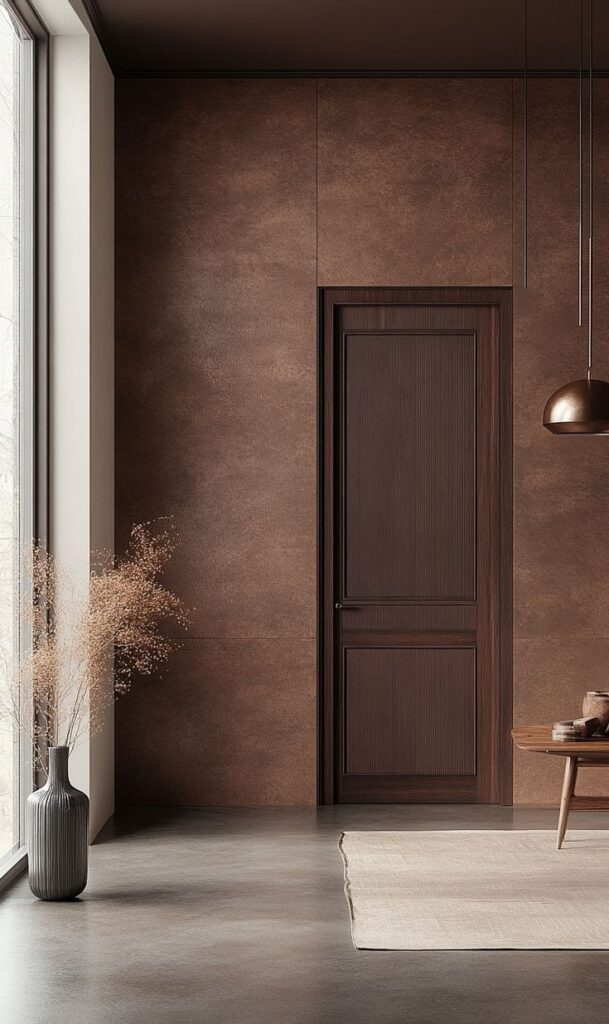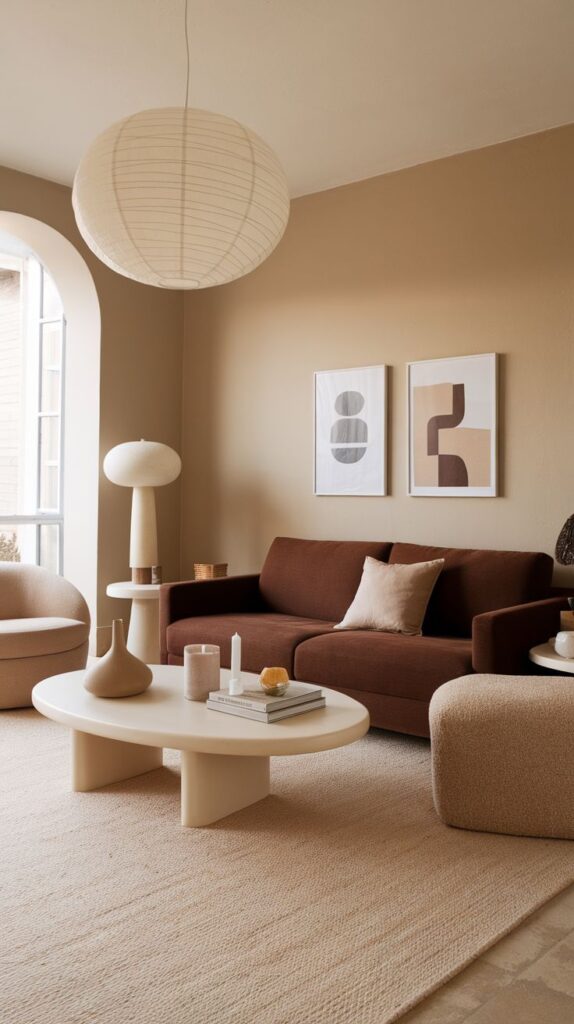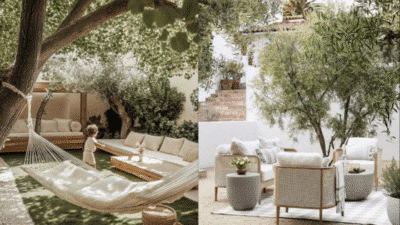

Brown Pantone colors bring warmth and versatility to home design. Using brown tones from the Pantone palette can create a cozy and sophisticated atmosphere in any room. These shades work well on walls, furniture, and accessories, blending easily with other colors and styles.
Choosing the right brown can help balance natural elements and add depth to living spaces. Whether focusing on classic or modern looks, brown Pantone colors offer a reliable option for stylish and comfortable interiors. Understanding how to apply these colors can elevate a home’s overall feel without overwhelming the space.
Key Takeaways
- Brown Pantone colors add warmth and balance to home interiors.
- They work well with different design styles and materials.
- Proper lighting and placement enhance the impact of brown shades.
Understanding Brown in Pantone Design
Brown in Pantone design covers a wide range of warm, earthy tones used to create cozy and inviting spaces. These shades vary from light tans to deep chocolates, each offering different moods. The way brown is used can influence the feeling of comfort, stability, and style in a home.
What Is the Pantone Brown Color Palette?


The Pantone brown color palette includes several tones that range from soft beiges to rich, dark browns. These colors are classified by Pantone with specific codes for accurate reproduction in design projects.
Common Pantone browns include:
- Pantone 7517 C: A warm, medium brown with orange undertones.
- Pantone 466 C: A light, sandy brown often used for neutral backgrounds.
- Pantone 476 C: A dark, chocolate brown for accent details.
These tones allow designers to choose the right brown for walls, furniture, or decor elements, ensuring consistency and harmony in the color scheme.
Popular Brown Pantone Shades for Homes


Some brown Pantone shades work better for certain home areas:
- Light Browns (Pantone 466 C, 7500 C): Ideal for walls and ceilings to create a soft, natural light.
- Medium Browns (Pantone 7517 C, 465 C): Great for wooden furniture or flooring, providing warmth without overwhelming the space.
- Dark Browns (Pantone 476 C, 7583 C): Used for accent walls, cabinets, or accessories that add depth and contrast.
Choosing the right shade depends on room size, lighting, and existing decor. Browns blend well with greens, creams, and tans, making them versatile in most home styles.
Psychology of Brown in Interior Spaces
Brown is often linked to feelings of stability, reliability, and warmth. It is seen as grounding and comforting, which makes it popular for creating welcoming interiors.
In spaces where people want to feel relaxed and secure—such as living rooms or bedrooms—brown helps set a calm tone. It also promotes a connection to nature due to its earthy quality. However, too much dark brown can feel heavy or oppressive, so balancing it with lighter tones or natural light is important.
Incorporating Brown Pantone Colors Into Home Interiors
Brown Pantone colors bring warmth and depth to a home. Choosing the right shade, pairing it with other tones, and using it on accent walls can change the mood and style of a room.
Selecting the Right Brown Pantone for Your Style


Choosing the right brown depends on the room’s purpose and the homeowner’s style. Darker browns, like Pantone 19-0912, work well in formal spaces or rooms needing a cozy feel. Lighter browns, such as Pantone 16-1328, fit casual areas or those wanting a soft, earthy look.
It’s also important to consider natural light. Rooms with little sunlight benefit from lighter brown tones that open up space. Rooms with lots of light can handle richer, deeper browns without feeling cramped.
Combining Brown Pantone With Other Colors


Brown pairs well with many colors but works best with neutrals and muted tones. Using creams, soft whites, or beige alongside brown creates a balanced, warm environment. For a modern touch, browns combined with olive green or dusty blue offer a calm, natural palette.
Bright colors, like orange or mustard yellow, can add energy and highlight features when used sparingly with brown. Using a color chart helps visualize these combinations first:
| Brown Pantone | Complementary Colors | Notes |
|---|---|---|
| 19-0912 | Cream, Mustard Yellow | Warm, classic look |
| 16-1328 | Olive Green, Soft White | Earthy, relaxed atmosphere |
Accent Walls Using Brown Pantone


Using brown on an accent wall focuses attention and adds depth to a room. Dark brown accent walls work well behind sofas or beds to anchor the space and create a strong contrast with lighter furniture.
For smaller rooms, lighter browns on accent walls can add warmth without making the space feel smaller. Matte finishes on brown walls reduce glare and create a soft, inviting vibe. Choosing an accent wall near natural light sources keeps the brown vibrant and attractive.
Brown Pantone Trends in Home Design
Brown Pantone colors in home design balance warmth and versatility. They work well in many styles and continue to evolve with new shades and uses. Understanding where and how to use brown can help make spaces feel inviting and fresh.
Modern vs. Traditional Brown Applications


Modern design often uses cooler, muted browns like taupe or greige. These shades pair well with clean lines, metal, and glass to create a sleek, minimalist look. In furniture, leather or wood with smooth finishes adds a contemporary touch without overwhelming the room.
Traditional design favors rich, warm browns like chestnut or mahogany. These colors appear in heavy wood furniture, ornate details, and classic patterns. They bring a cozy, timeless feel to spaces like libraries or living rooms. Traditional brown often mixes with earth tones to deepen a room’s warmth.
Emerging Brown Pantone Trends


Earthy brown tones are gaining popularity in eco-friendly interiors. Colors like burnt sienna and warm terracotta reflect natural materials and create calm environments. Designers combine these with natural textiles and plants for a soft, organic aesthetic.
Another trend is using brown as an accent color against whites and creams. This adds depth without darkening a space. Matte and textured finishes in brown are also on the rise, giving walls and furniture a more tactile, interesting look.
| Trend | Description | Common Uses |
|---|---|---|
| Earth tones | Natural, warm browns like terracotta | Walls, textiles, decor items |
| Brown accents | Brown used with whites and creams | Pillows, vases, trims |
| Matte & textured browns | Soft, tactile finishes in brown shades | Cabinets, furniture, walls |
Brown Pantone in Furnishings and Decor
Brown Pantone colors bring warmth and depth to a room. Using them in furniture, textiles, and artwork can create a balanced and cozy space. The key is to choose pieces that highlight the brown tones without overpowering the room.
Choosing Brown Pantone Furniture


Furniture in brown Pantone shades adds a natural and strong foundation to any space. Look for materials like leather, wood, or suede in tones such as Chocolate Brown, Caramel, or Burnt Sienna. These colors work well for sofas, chairs, and tables.
Brown furniture pairs nicely with neutral walls or lighter accent colors. It helps ground the room while providing a soft but solid feel. Avoid overly dark browns in small rooms, as they can make spaces feel cramped. Instead, use mid-tone browns to keep things open yet inviting.
Textiles and Accessories in Brown Pantone


Adding textiles such as cushions, throws, and rugs in brown Pantone shades introduces warmth without heavy commitment. Fabrics with soft browns like Clay or Sepia bring subtle earthiness to a room.
Accessories like lampshades, curtains, and decorative pillows can use these browns to tie decor together. Pair brown textiles with creams, beiges, or muted greens for a calm, natural look. Mixing textures—like velvet with linen—enhances interest while maintaining simplicity.
Artwork and Decorative Pieces


Artwork with brown Pantone tones adds depth and interest to walls and shelves. Look for paintings or prints that feature browns in combination with greens, golds, or blues. These color mixes highlight the richness of brown without making it dull.
Decorative elements such as vases, bowls, and sculptures in brown shades can balance other colors in the room. Choose matte or slightly textured finishes to avoid glare and keep the mood grounded. Small touches with brown decor complete the look without overwhelming the space.
Lighting Considerations for Brown Pantone Spaces
Lighting plays a key role in how brown tones appear in a room. Proper light can bring out warmth or make the space feel dull. Choosing the right type and intensity of light enhances the color’s natural depth.
Natural Light and Brown Pantone


Natural light affects brown shades by highlighting their undertones. Warm browns look richer in soft, morning sunlight. Cooler browns may seem slightly gray or muted in bright, midday light.
Rooms with large windows benefit most from natural light when using brown Pantone colors. Sheer curtains can soften harsh sunlight to avoid washed-out colors. North-facing rooms may require lighter shades of brown to keep the space from feeling dark.
Natural light varies throughout the day, so it’s important to test brown paint or fabric samples at different times before finalizing choices. This will help to understand how the color shifts with changing light.
Artificial Lighting Strategies

Artificial lighting can be used to control how brown hues appear after sunset. Warm white bulbs (2700K to 3000K) enhance brown’s natural warmth and prevent the color from looking cold.
Layering different light sources helps maintain balance. For example:
- Ambient light for overall brightness
- Task lighting to highlight specific areas
- Accent lights to emphasize textures
Avoid harsh, cool white lights that can make brown tones appear dull or gray. Dimmers can also adjust lighting intensity, allowing the room’s brown colors to adapt to various moods or needs.
DIY Projects With Brown Pantone
Brown Pantone shades bring warmth and depth to any space. They work well in different creative projects around the home, allowing for both color richness and versatility.
Painting Techniques for Brown Pantone Walls


Using brown Pantone for walls often requires careful preparation. A matte or eggshell finish is best to show the color’s true tone without glare.
Applying two thin coats helps avoid streaks and uneven patches. It also enhances the richness of the brown color.
For added interest, try ombre effects with lighter shades of brown above and darker tones below. This creates a smooth, modern look.
Using painter’s tape, one can also make geometric designs or stripes with the brown Pantone color combined with whites or creams. This adds texture without overwhelming the room.
Upcycling and Customizing Decor


Brown Pantone paint can refresh old furniture, giving it a modern, earthy vibe. It works well on wood, metal, and even glass surfaces.
Sanding furniture before painting makes sure the color adheres well and looks smooth. A protective clear coat finishes the piece and adds durability.
Custom decor pieces like planters or picture frames can be painted in different brown tones for a matched look throughout a room.
Using stencils with brown paint lets one create patterns on pillows or lampshades. This technique adds a subtle, stylish touch without the need for buying new items.
Brown Pantone Maintenance and Care


Brown Pantone colors are known for their warmth and depth. To keep them looking fresh, it is important to avoid direct sunlight for long periods. Sunlight can cause the color to fade over time.
When cleaning surfaces or fabrics with brown Pantone shades, use a soft cloth or sponge. Mild soap and water work best. Harsh chemicals or abrasive materials may damage the color.
For painted walls or wooden furniture, dusting regularly helps maintain the finish. Use a dry or slightly damp cloth to remove dirt. Avoid soaking the surface, as excess moisture can cause damage.
If stains appear on fabrics or upholstery, spot clean immediately. Blot gently instead of rubbing, which can spread the stain. Test any cleaning product on a hidden area first to check for colorfastness.
Brown Pantone tones pair well with natural materials like wood and leather, which also require specific care. For leather, use specialized conditioners to prevent cracking. For wood, apply polish occasionally to keep the surface smooth and vibrant.
Keep the indoor humidity levels balanced. Too much moisture can affect paints and fabrics, while too little can cause cracking or fading. A humidifier or dehumidifier may help maintain the right conditions.
These care steps will help preserve the color and texture of brown Pantone elements at home. Proper maintenance avoids costly repairs or repainting.
Sustainable Choices With Brown Pantone


Brown Pantone shades are often linked to nature and earth, making them a popular choice in sustainable design. These colors can create a warm, inviting space that feels grounded and eco-friendly.
Using natural materials with brown tones supports sustainability. Wood, clay, and recycled fabrics match well with brown and reduce the use of synthetic products. They also tend to last longer, cutting down waste.
Choosing low-VOC (volatile organic compounds) paints in brown hues helps improve indoor air quality. These paints release fewer harmful chemicals, which benefits health and the environment.
Here is a simple list of sustainable items to pair with brown Pantone designs:
- Bamboo furniture
- Organic cotton textiles
- Recycled metal fixtures
- Cork flooring
Brown shades work well with plants, too. Adding greenery not only enhances the look but boosts air quality and connects the room to nature.
Using energy-efficient LED lights with warm brown lampshades adds to sustainability. It lowers electricity use without changing the cozy atmosphere.
Tables and decor made from upcycled or reclaimed materials highlight sustainable design. These pieces add character while reducing demand for new resources.
Incorporating brown Pantone in sustainable design is practical and attractive. It encourages mindful choices without sacrificing style.
- 0shares
- Facebook0
- Pinterest0
- Twitter0



